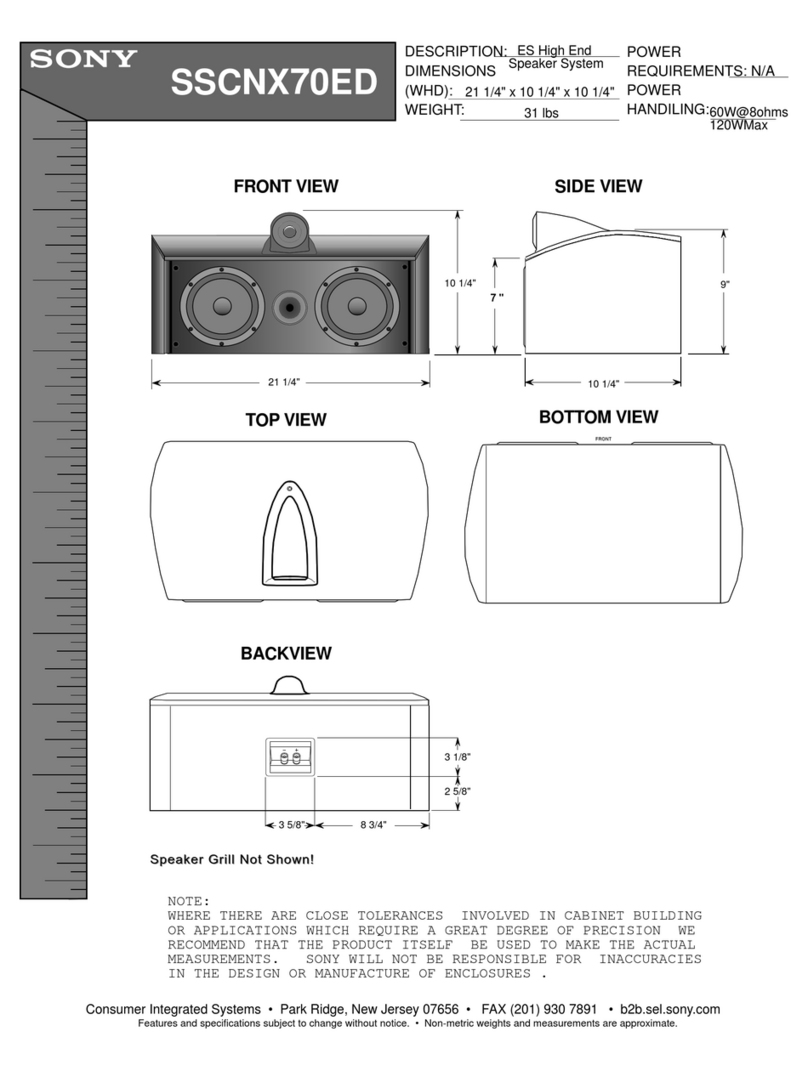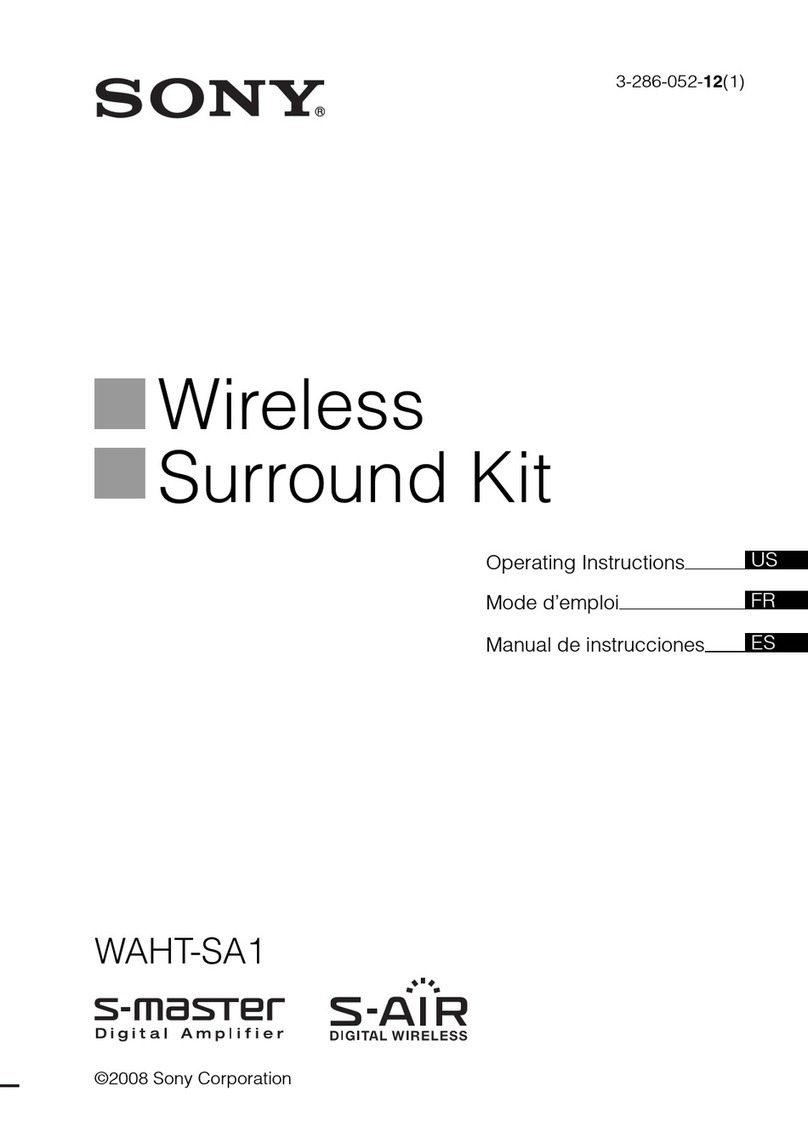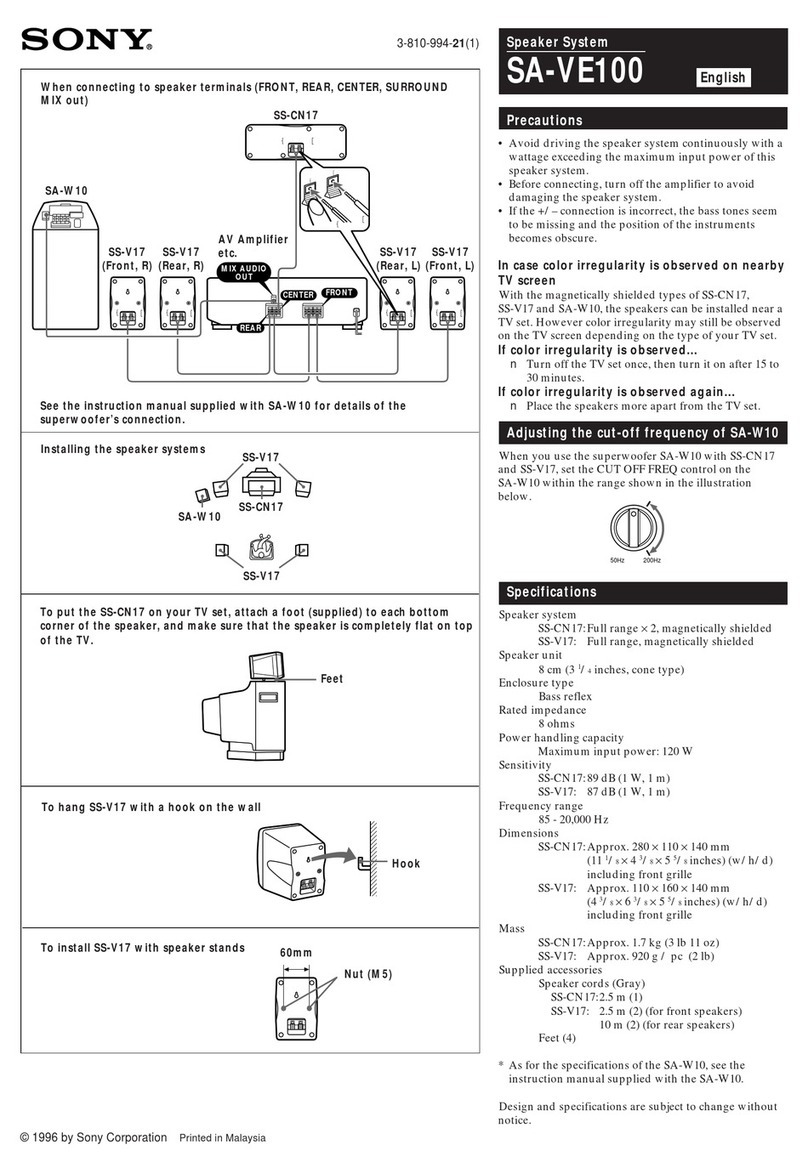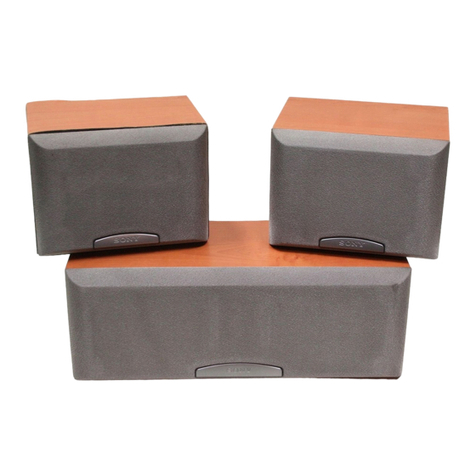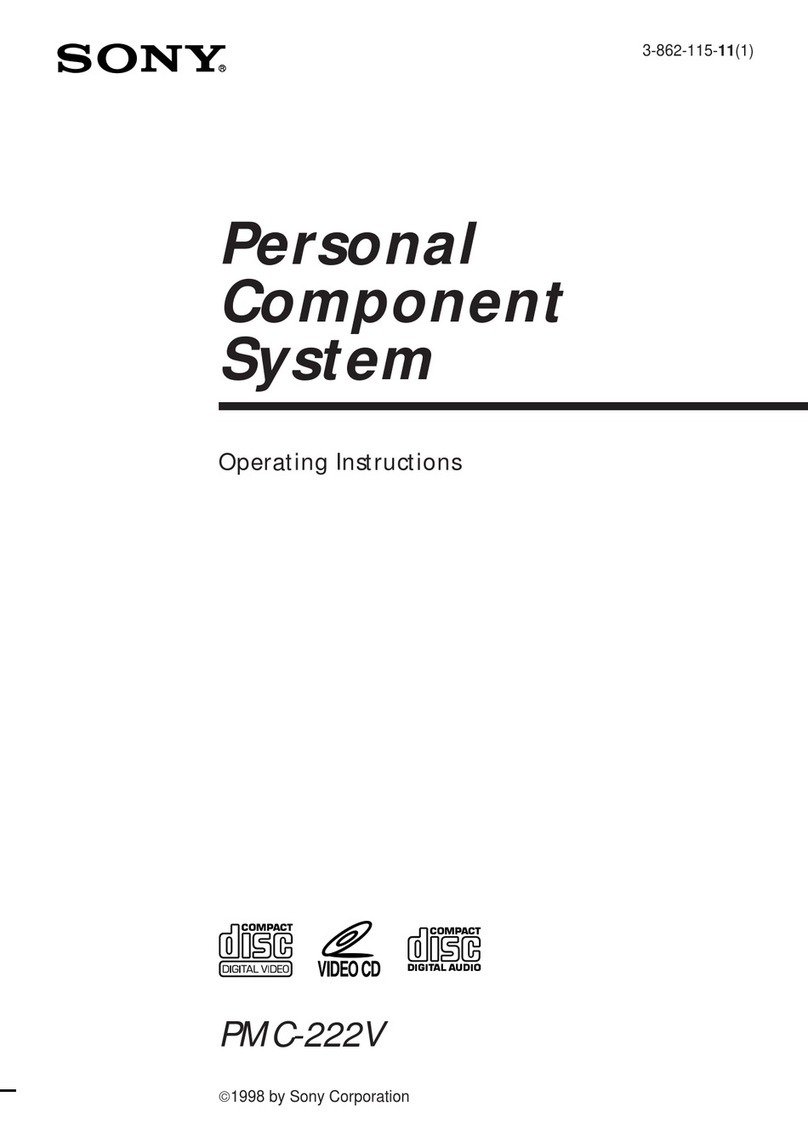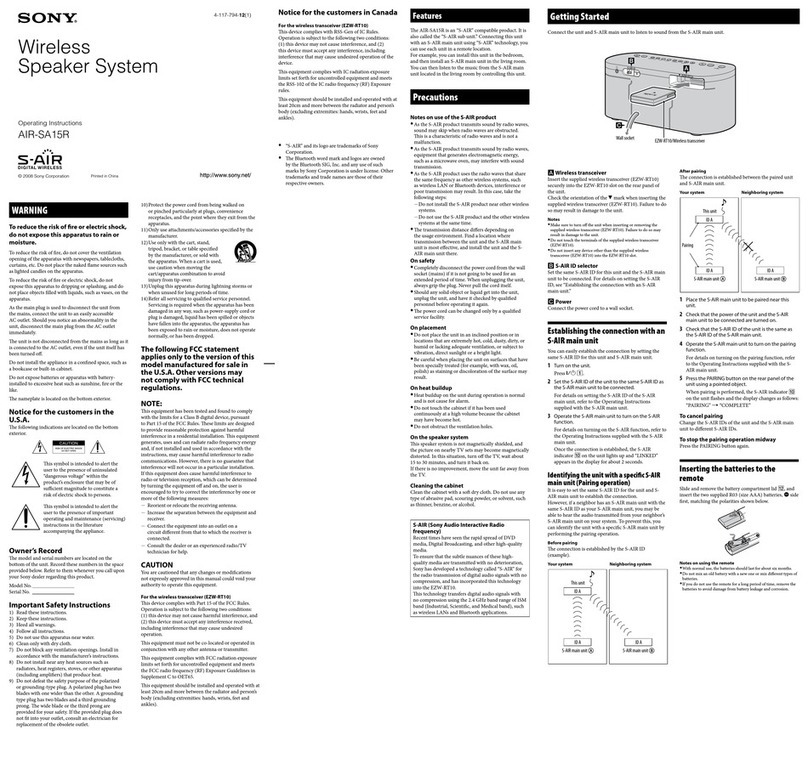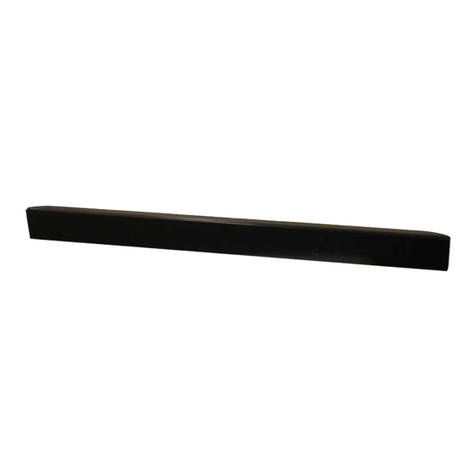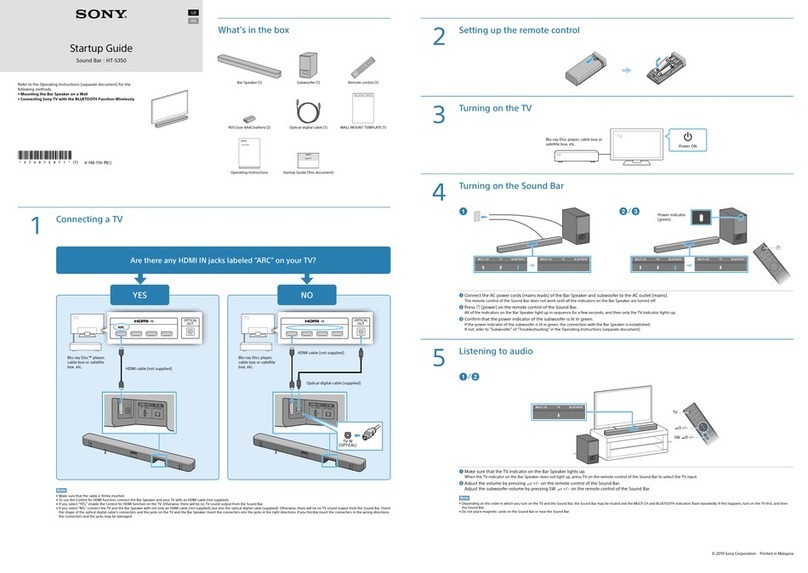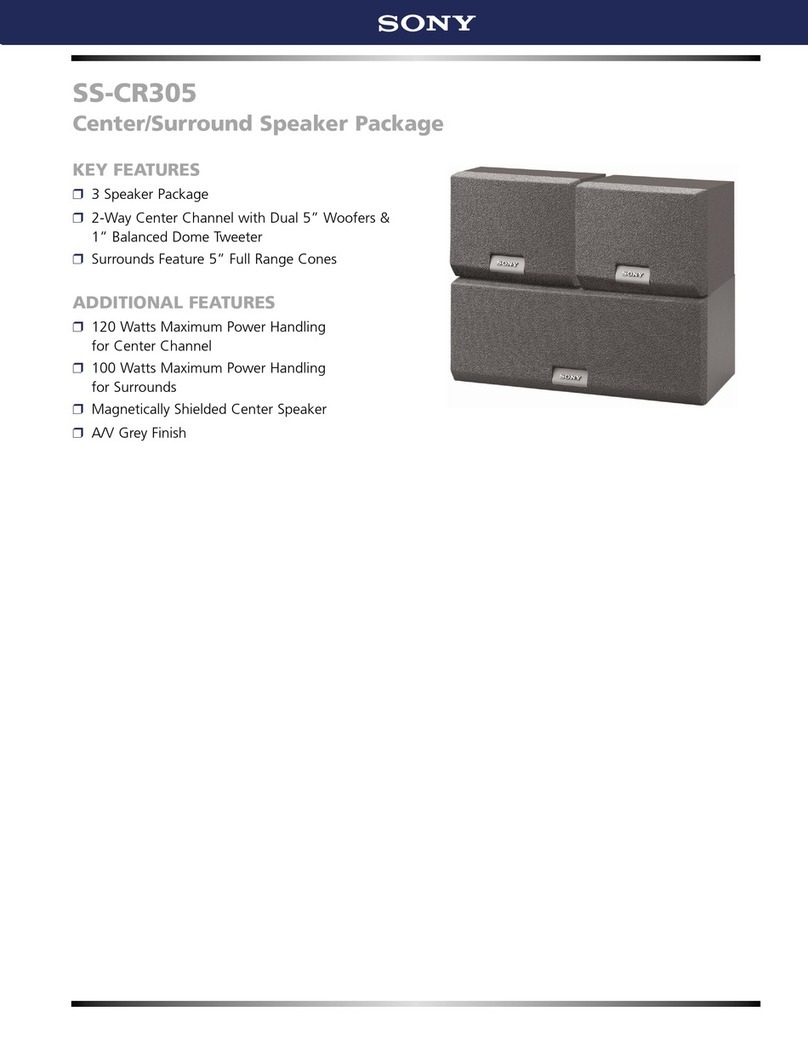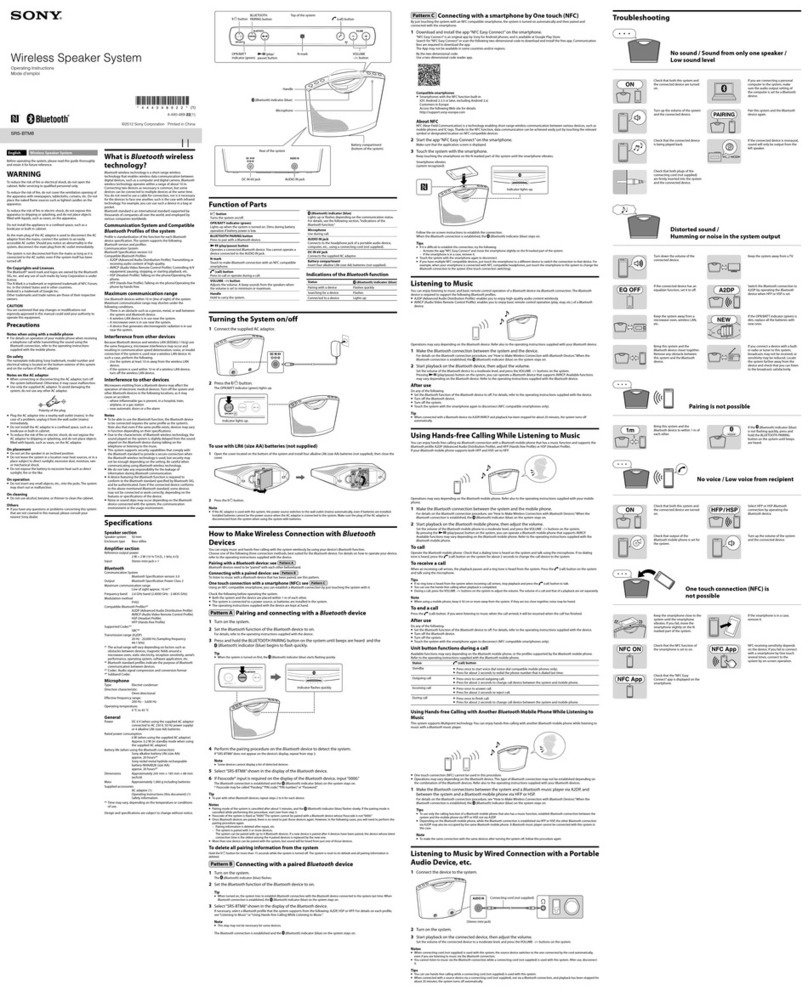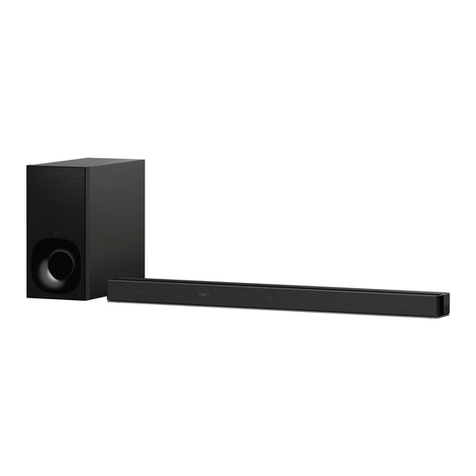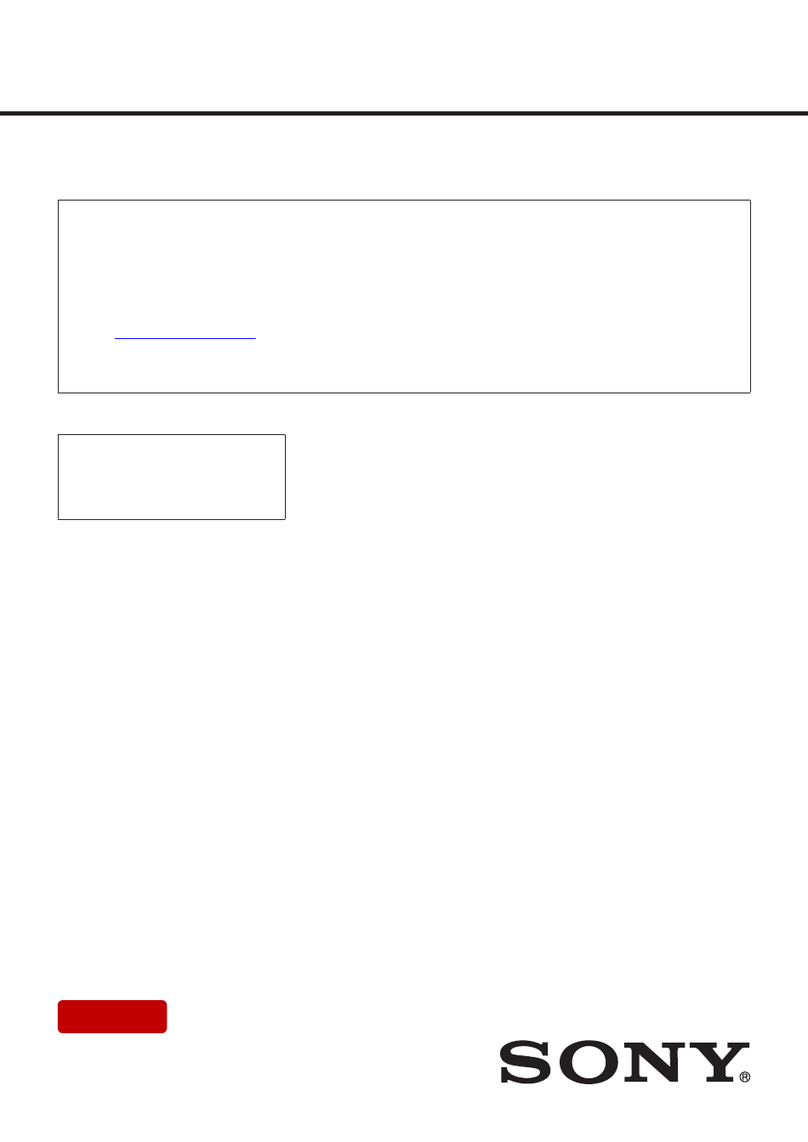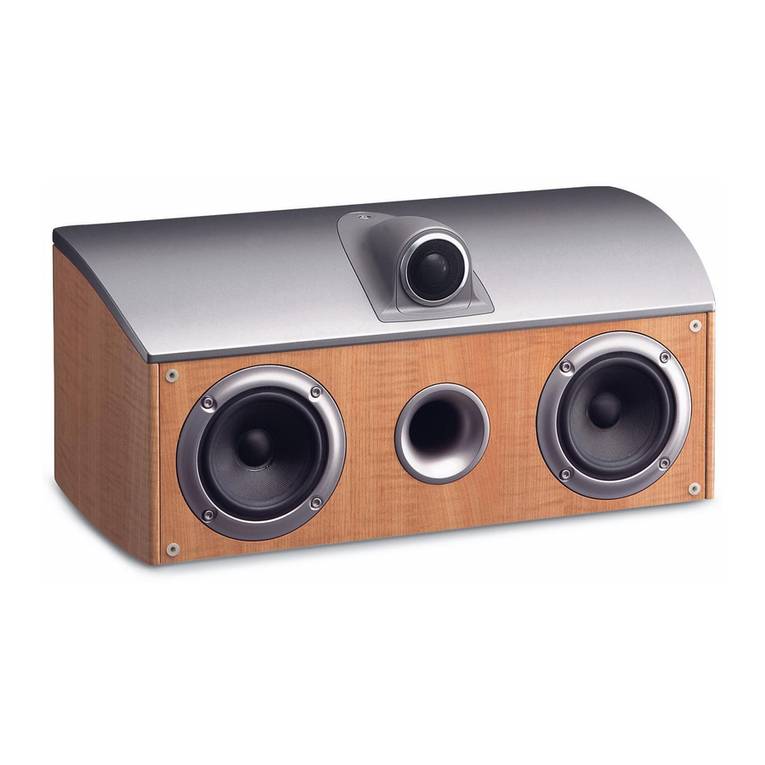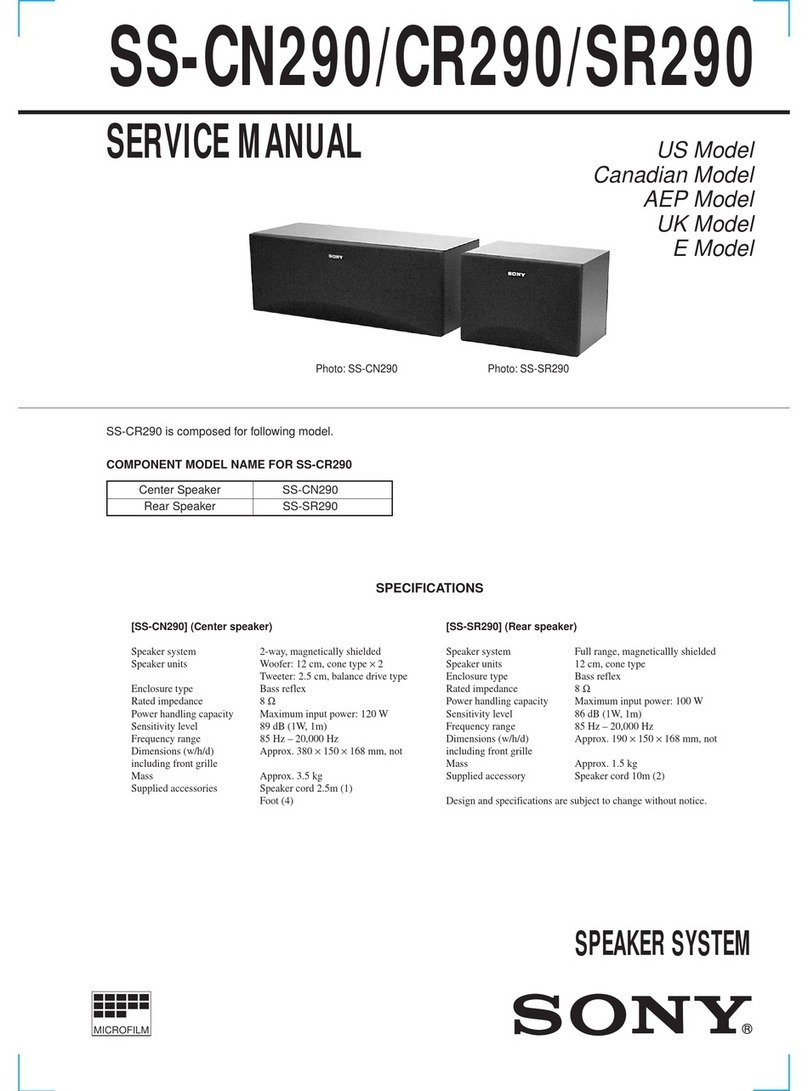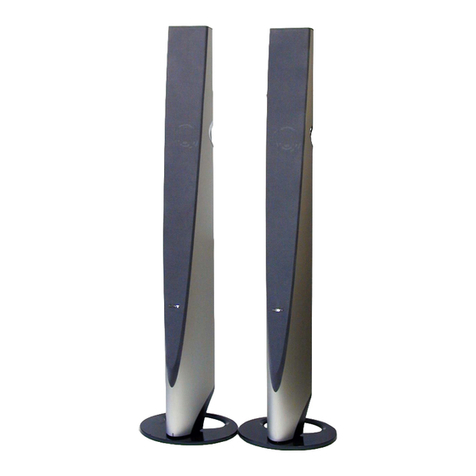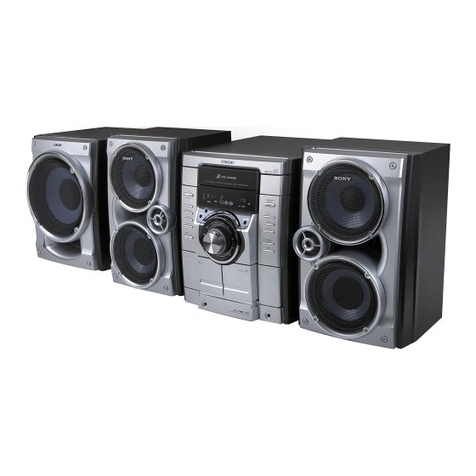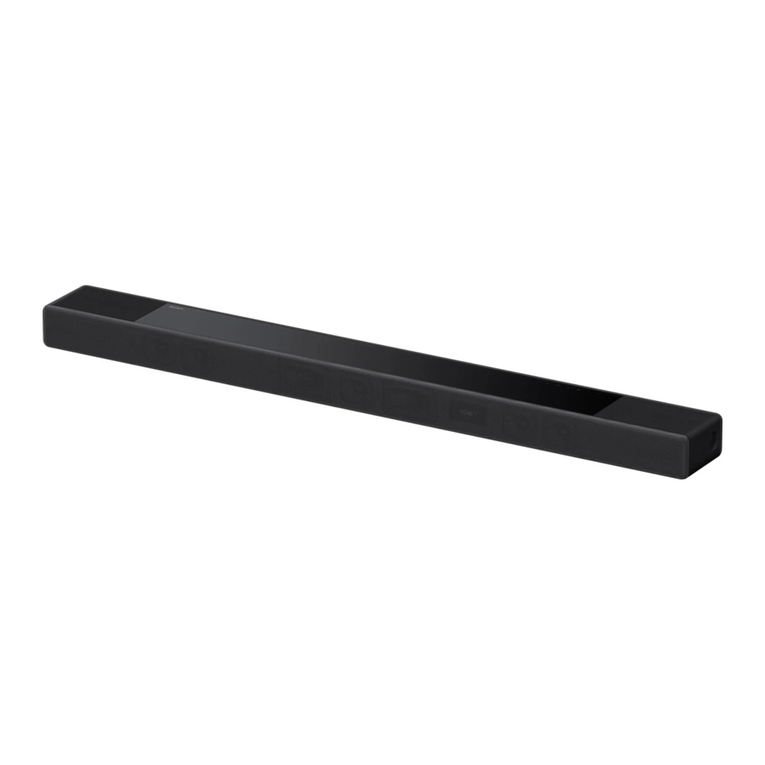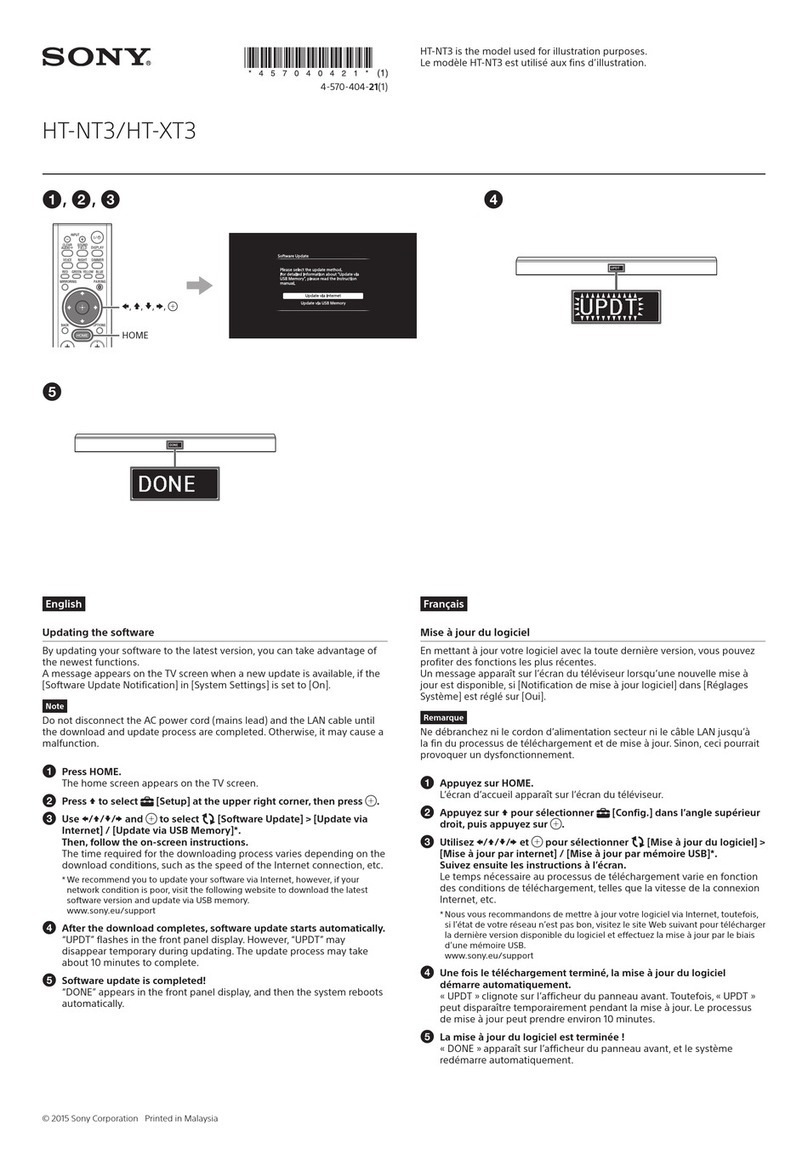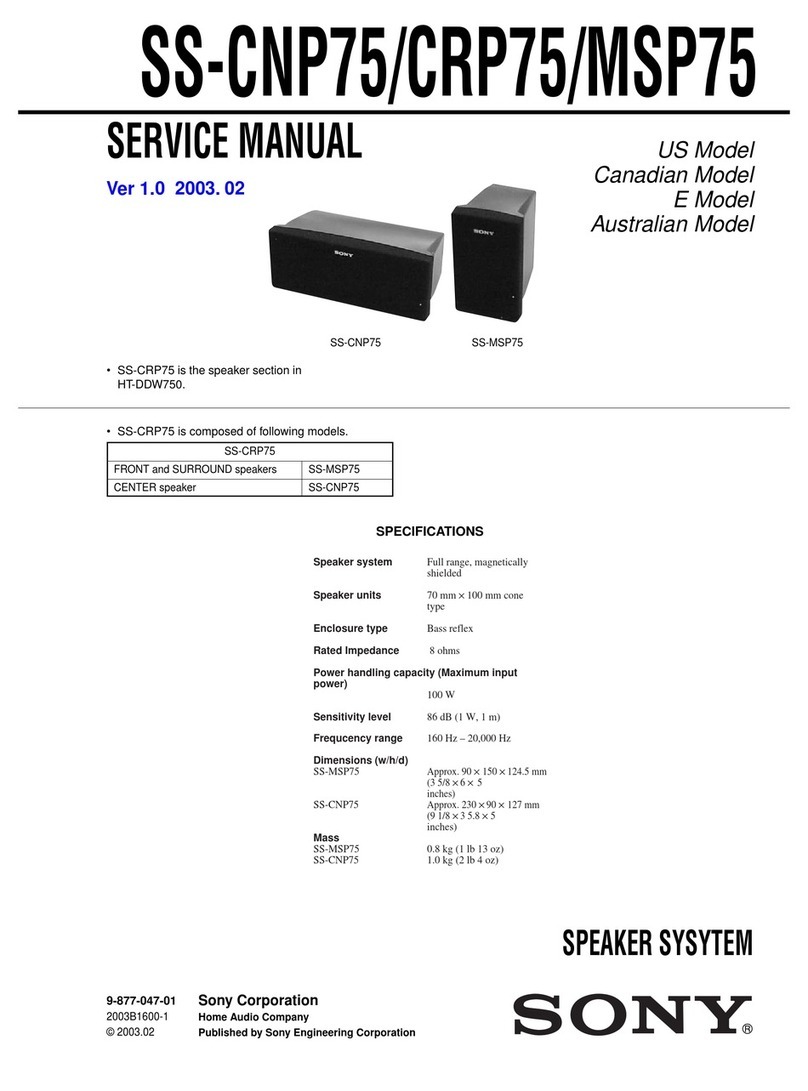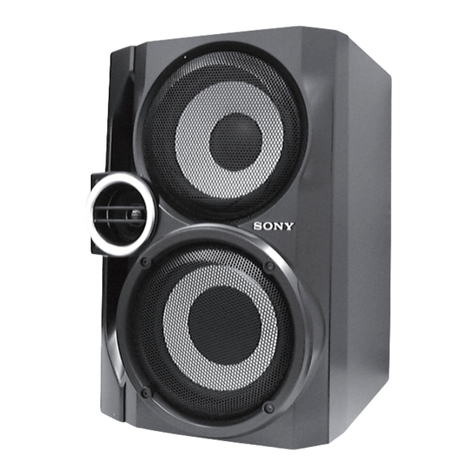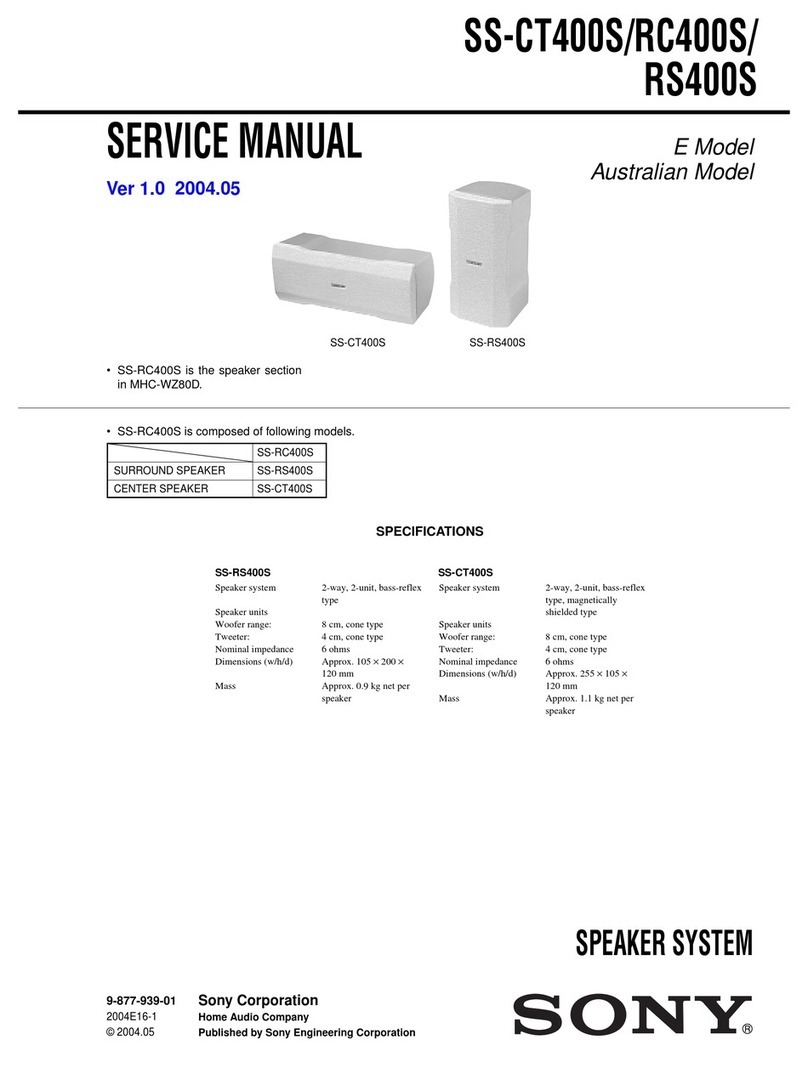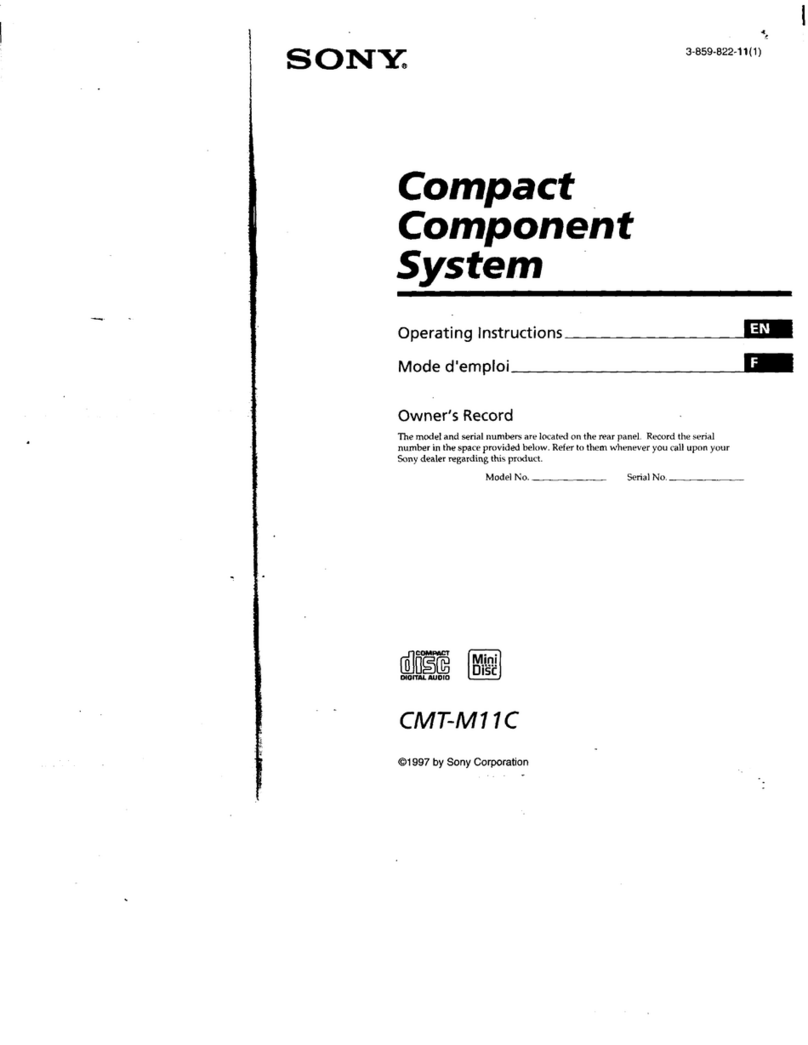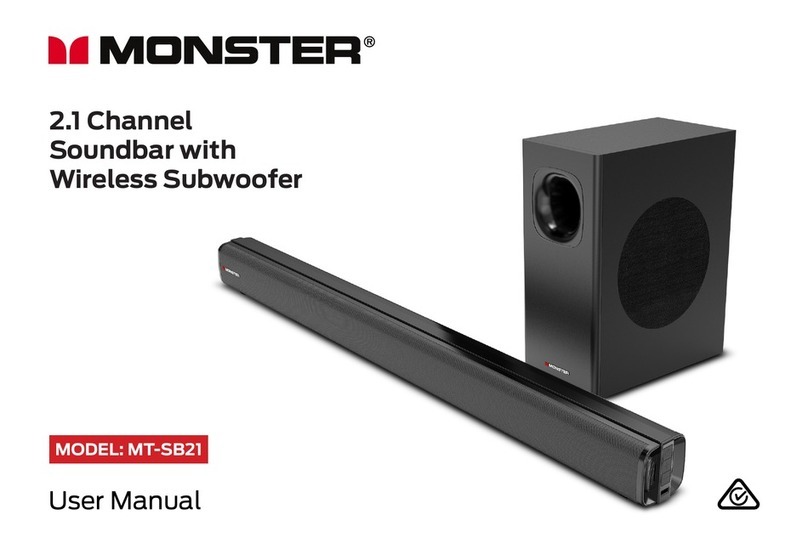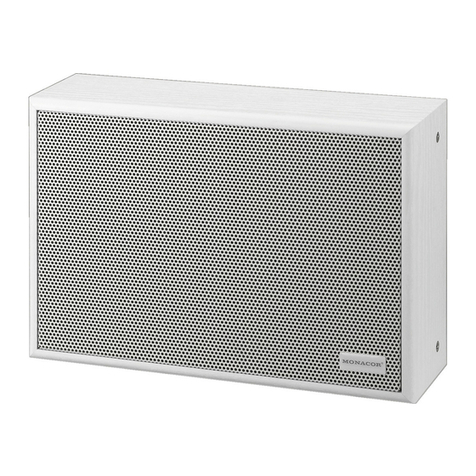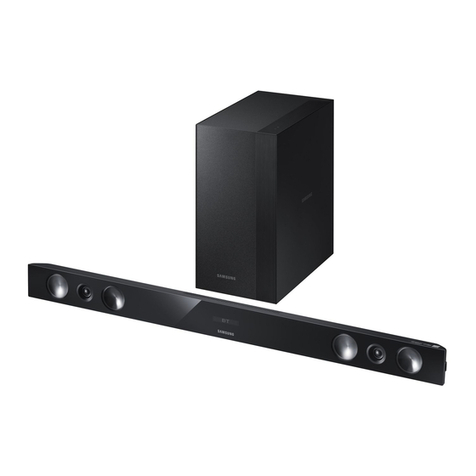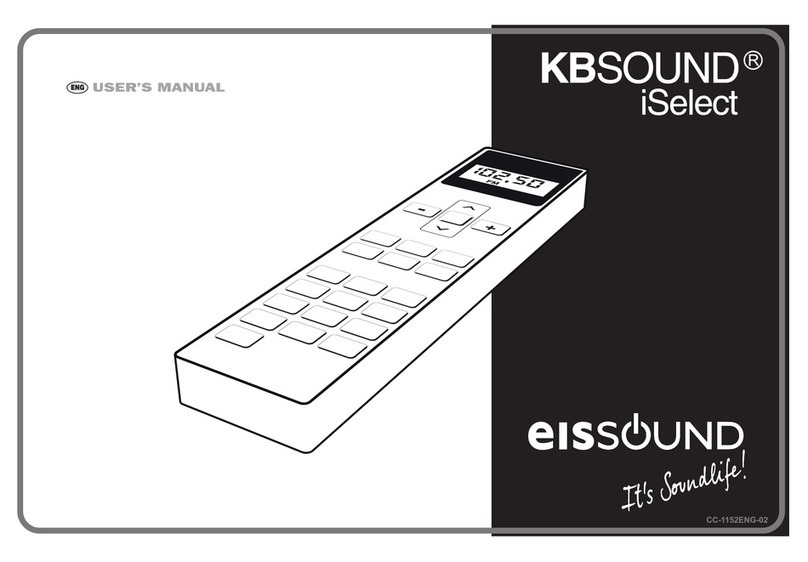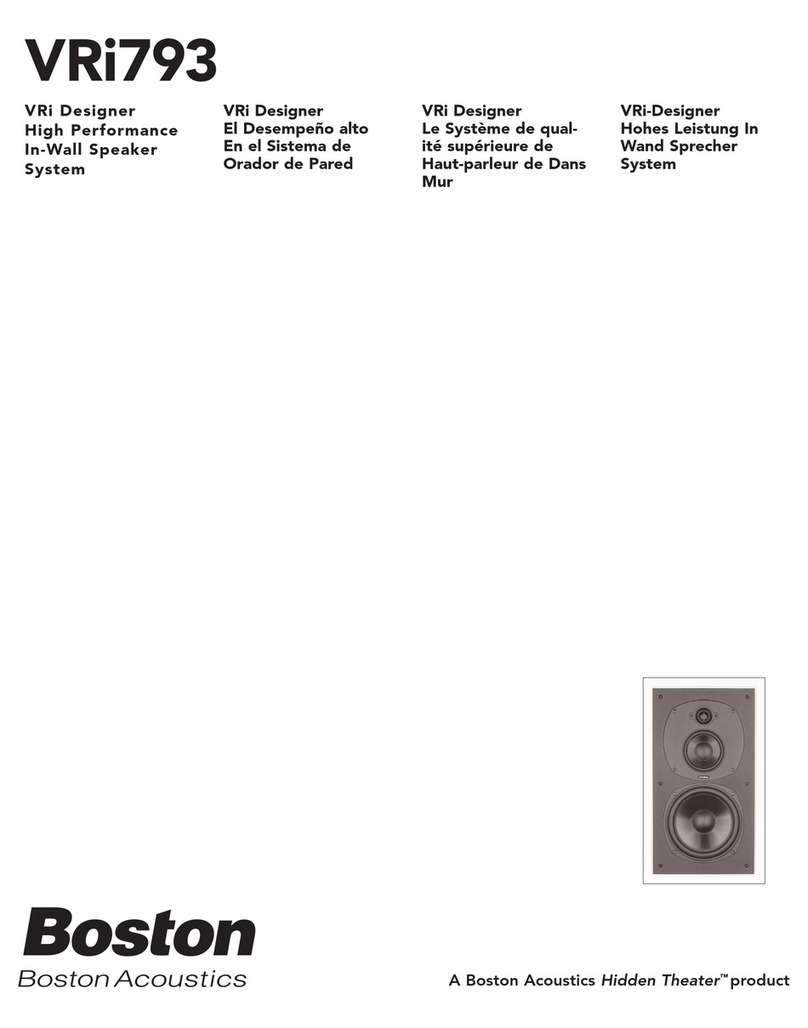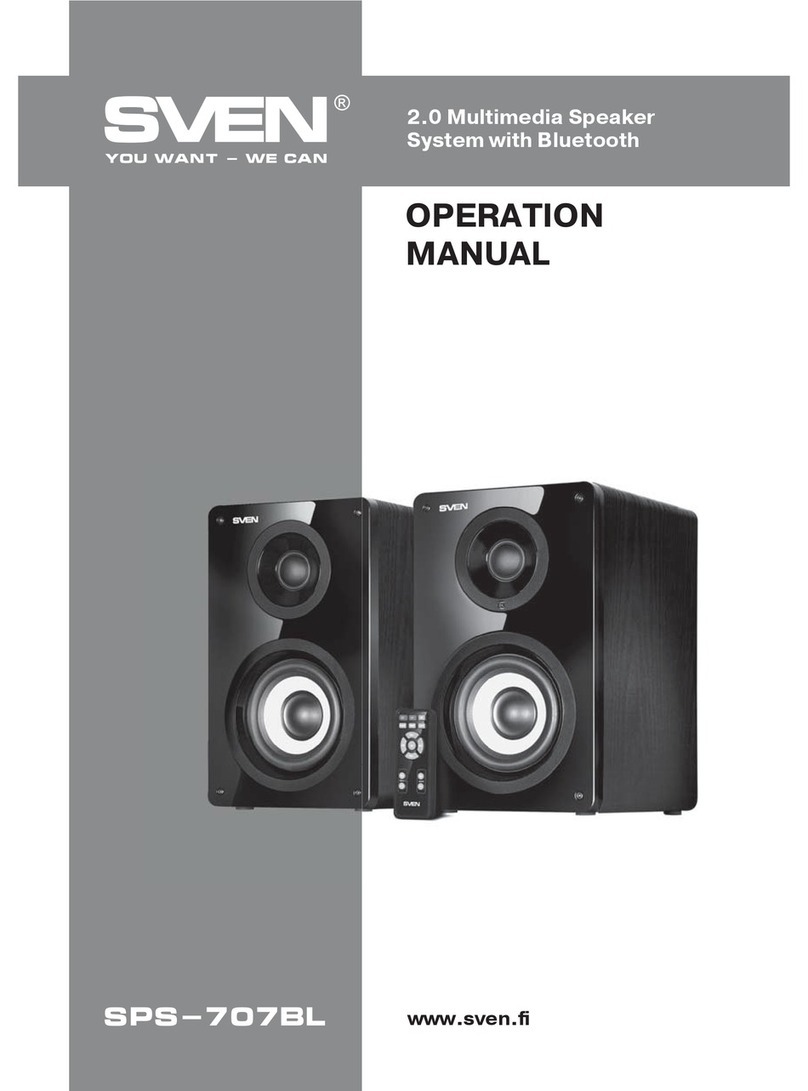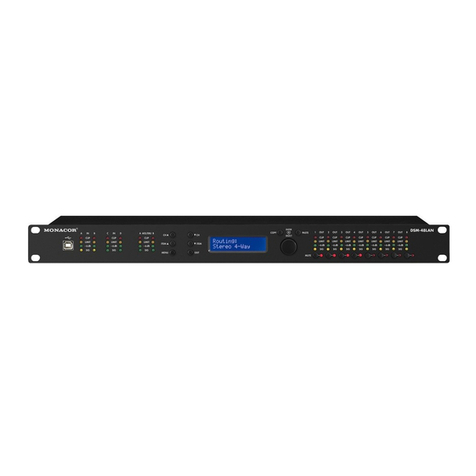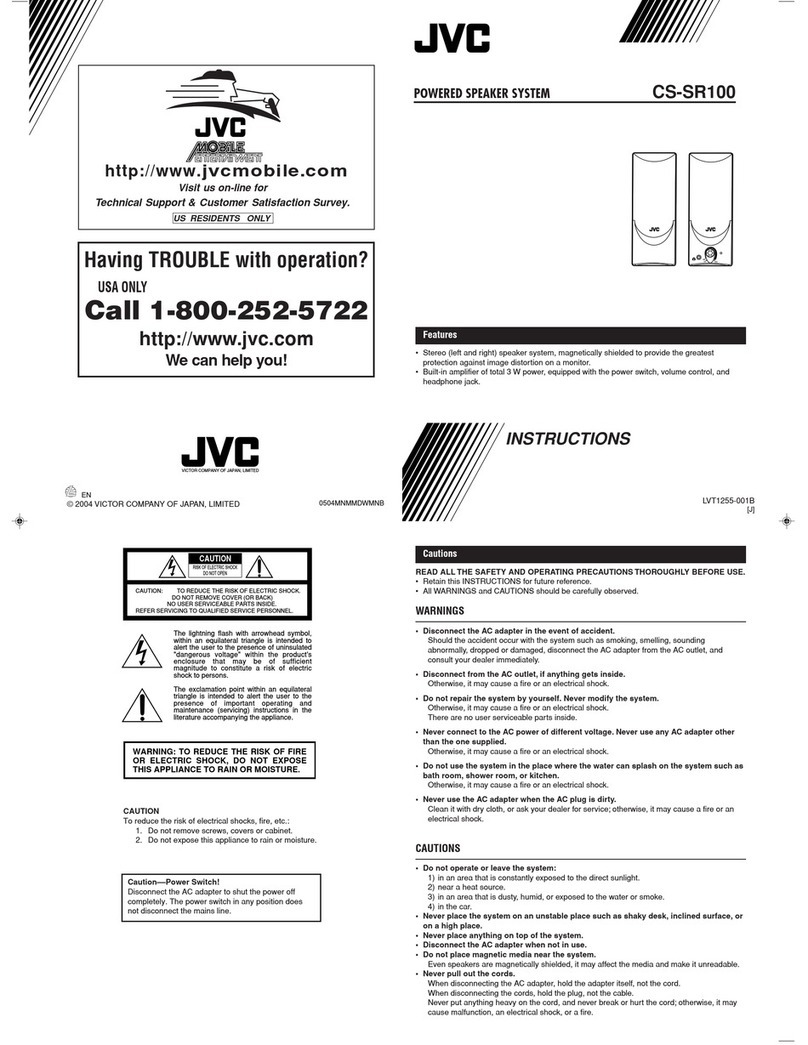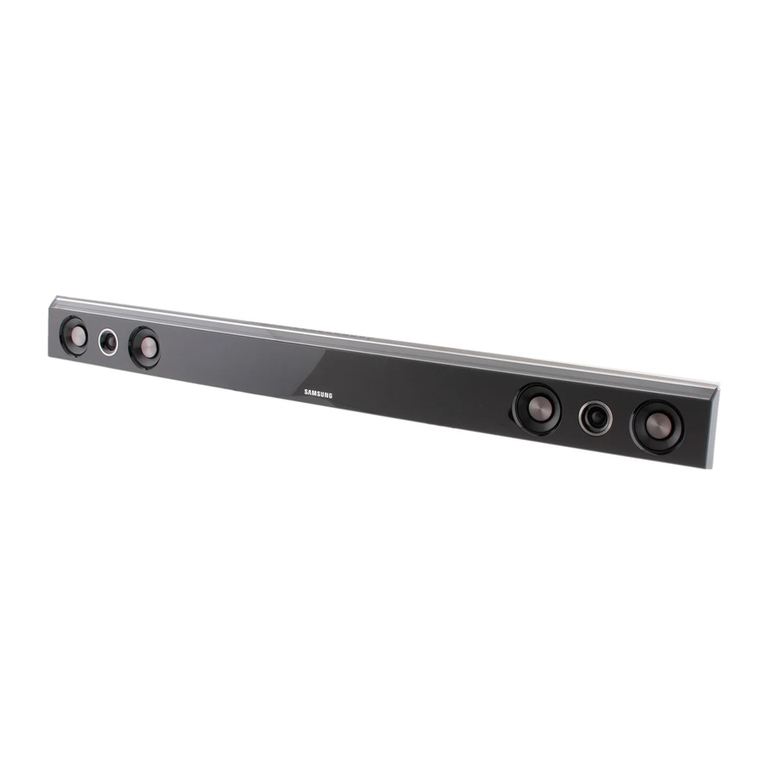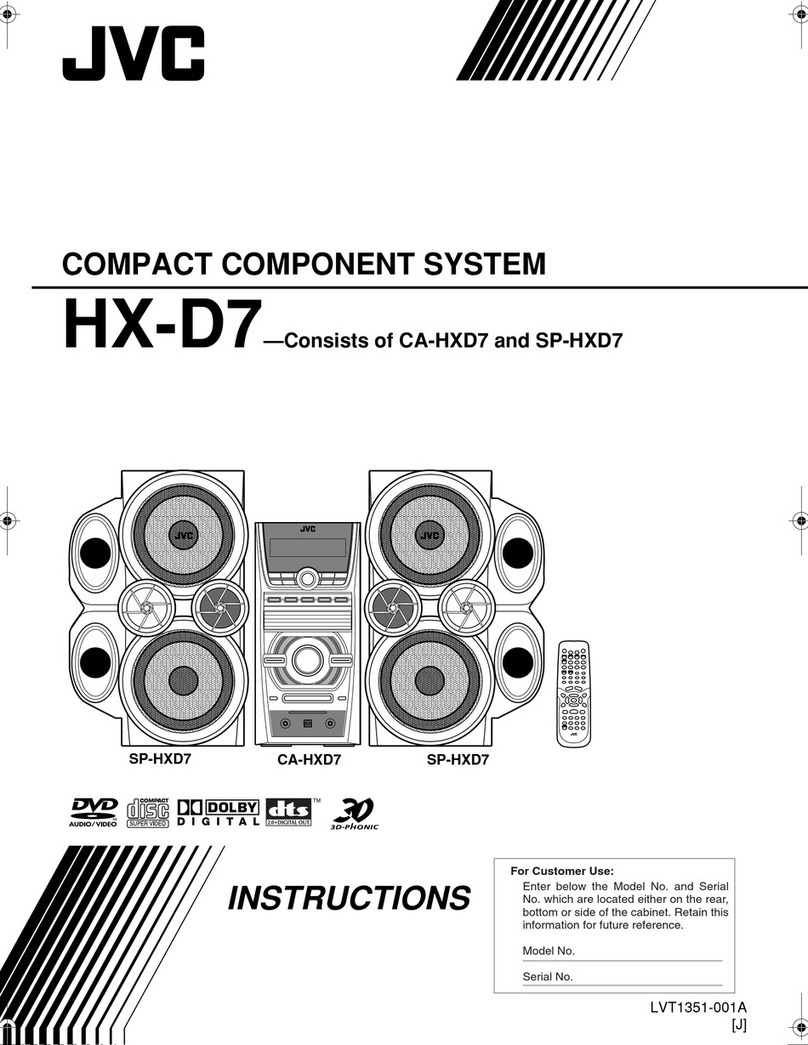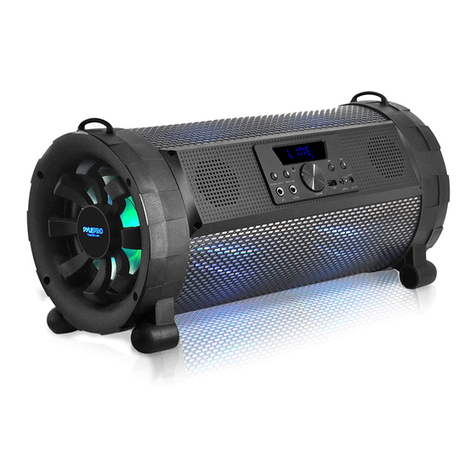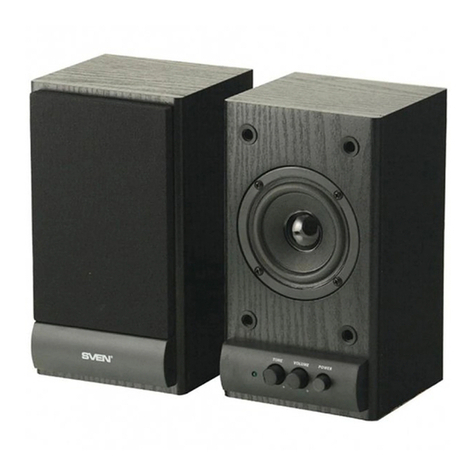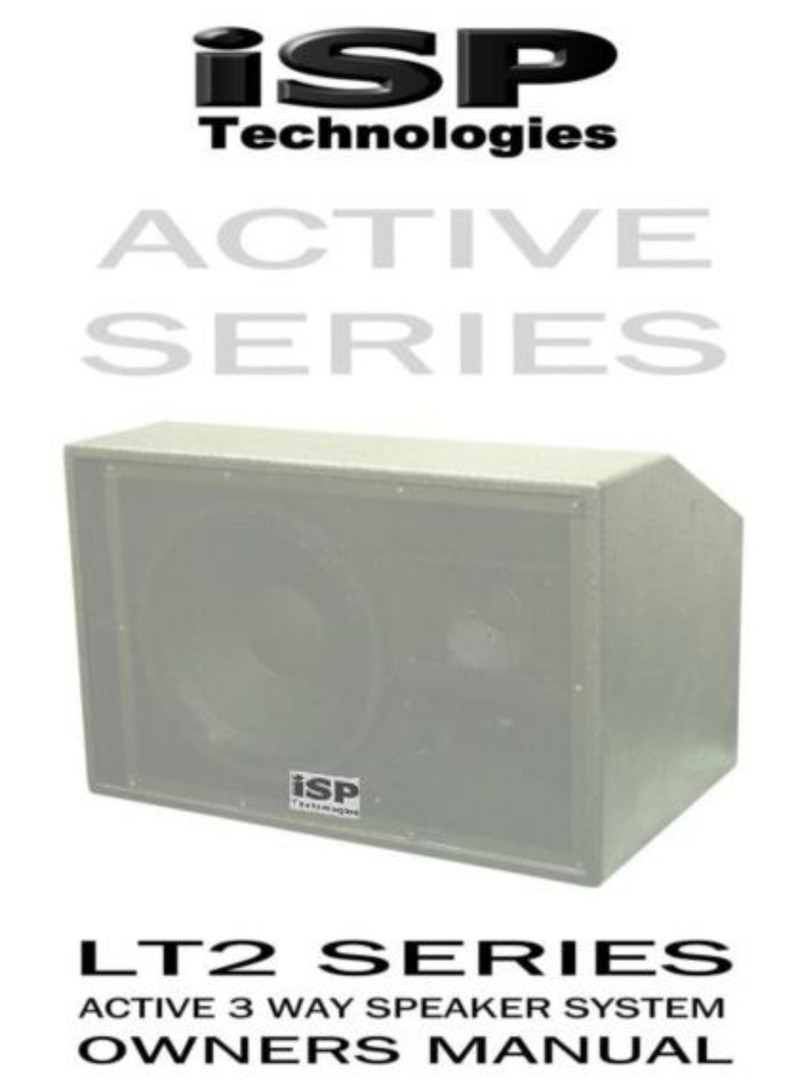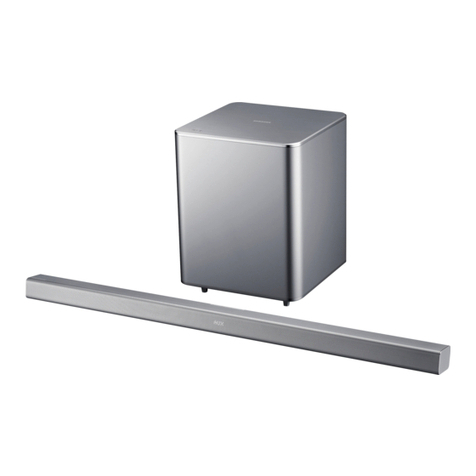Función de las piezas
Botón /
Apaga/enciende el sistema.
Indicador de OPR/BATT (verde)
Se ilumina cuando se enciende el sistema. Se atenúa durante
el funcionamiento con batería si la alimentación de la batería
es baja.
Botón BLUETOOTH PAIRING
Presione para emparejar con un dispositivo Bluetooth.
botón (reproducir/pausa)
Opera un dispositivo Bluetooth conectado. No puede operar
un dispositivo conectado al contacto AUDIO IN.
Marca N
Presione para establecer una conexión Bluetooth con un
teléfono inteligente compatible con NFC.
Botón (llamar)
Presione para llamar u operar durante una llamada.
Botón VOLUME −/+
Ajusta el volumen. Se escucha un bip por los altavoces cuando
el volumen se ajusta al mínimo o al máximo.
Manija
Agarre para transportar el sistema.
Indicador (Bluetooth) (azul)
Se ilumina o parpadea en función del estado de comunicación.
Para obtener más información, consulte la siguiente sección,
“Indicaciones de la función Bluetooth”.
Micrófono
Se utiliza durante una llamada.
Toma AUDIO IN
Se conecta a la toma de auriculares de un dispositivo de audio
portátil, computadora, etc., mediante un cable de conexión
(no suministrado).
Toma DC IN 6V
Conecta el adaptador de CA suministrado.
Compartimento de las baterías
Introduzca cuatro baterías alcalinas LR6 (tamaño AA) (no
suministradas).
Indicaciones de la función Bluetooth
Estado Indicador (Bluetooth) (azul)
Emparejamiento con un
dispositivo
Parpadea rápidamente
Buscando un dispositivo Parpadea
Conectado a un dispositivo Se ilumina
Apagado/encendido del sistema
1 Conecte el adaptador de CA suministrado.
2 Presione el botón /.
Se ilumina el indicador OPR/BATT (verde).
El indicador se ilumina.
Para usar con baterías LR6 (tamaño AA) (no suministradas)
1 Abra la tapa ubicada en la parte inferior del sistema e instale cuatro baterías alcalinas LR6 (tamaño AA) (no suministradas) y luego
cierre la tapa.
2 Presione el botón /.
Nota
Si el adaptador de CA se utiliza con el sistema, la fuente de alimentación se cambia a la toma de pared (red eléctrica) automáticamente, incluso
si tiene baterías. Las baterías colocadas no pueden ser la fuente de alimentación cuando el adaptador de CA está conectado al sistema.
Asegúrese de que el enchufe del adaptador de CA esté desconectado del sistema cuando utiliza el sistema con baterías.
Cómo realizar una conexión inalámbrica con
dispositivos Bluetooth
Puede disfrutar de la música o hacer llamadas con manos libres con el sistema de manera inalámbrica al utilizar la función Bluetooth de
su dispositivo.
Elija uno de los siguientes tres métodos de conexión, el que mejor se adapte al dispositivo Bluetooth. Para obtener más información
acerca de cómo operar su dispositivo, consulte el manual de instrucciones suministrado con el dispositivo.
Emparejamiento con un dispositivo Bluetooth: ver Patrón A
Los dispositivos Bluetooth deben“emparejarse”entre ellos con anticipación.
Conectarse con un dispositivo emparejado: ver Patrón B
Para escuchar música con un dispositivo Bluetooth que se ha emparejado, vea este patrón.
Conexión de un solo toque con un teléfono inteligente (NFC): ver Patrón C
Al utilizar un teléfono inteligente compatible con NFC, puede establecer una conexión Bluetooth simplemente al tocar el sistema con
este.
Lea lo siguiente antes de hacer funcionar el sistema.
El sistema y el dispositivo están ubicados dentro de 1 m (3 pies) uno del otro.
El sistema está conectado a una fuente de alimentación o hay baterías colocadas en el sistema.
El manual de instrucciones suministrado con el dispositivo está a mano.
Patrón A Emparejamiento y conexión con un dispositivo Bluetooth
1 Encienda el sistema.
2 Encienda la función Bluetooth del dispositivo Bluetooth.
Para obtener más información, consulte el manual de instrucciones suministrado con el dispositivo.
3 Mantenga presionado el botón BLUETOOTH PAIRING del sistema hasta que se escuchen pitidos y el
indicador (Bluetooth) (azul) empiece a parpadear rápidamente.
Consejo
Cuando el sistema se enciende por primera vez, el indicador (Bluetooth) (azul) empieza a parpadear rápidamente.
El indicador parpadea rápidamente.
4 Realice el procedimiento de emparejamiento en el dispositivo Bluetooth para detectar el sistema.
Si no aparece“SRS-BTM8” en la pantalla del dispositivo, repita desde el paso 2.
Nota
Algunos dispositivos no pueden mostrar una lista de los dispositivos detectados.
5 Seleccione “SRS-BTM8”que se muestra en la pantalla del dispositivo Bluetooth.
6 Si en la pantalla del dispositivo Bluetooth se solicita que ingrese un Código de acceso*, introduzca
“0000”.
La conexión Bluetooth se ha establecido y el indicador (Bluetooth) (azul) del sistema permanece iluminado.
* El código de acceso puede denominarse“Clave de acceso”, “Código PIN”, “Número PIN” o “Contraseña”.
Consejo
Para emparejar con otros dispositivos Bluetooth, repita los pasos 2 a 6 para cada dispositivo.
Español Sistema de altavoces activos con
conexión Bluetooth
Antes de hacer funcionar el sistema, lea esta guía
cuidadosamente y guárdela para futuras consultas.
Registro del propietario
El número de modelo y el número de serie se encuentran en la
parte inferior.
Anote el número de serie en el espacio provisto a continuación.
Consúltelos cuando llame a su distribuidor Sony en relación con
este producto.
Nº de modelo SRS-BTM8
N.º de serie ______________________________
ADVERTENCIA
Para reducir el riesgo de incendios o electrocución, no exponga
el aparato a la lluvia ni a la humedad.
Para reducir el riesgo de incendios o descargas eléctricas, no
abra el gabinete. El mantenimiento solo debe realizarlo personal
calificado.
Para reducir el riesgo de incendios, no cubra la abertura de
ventilación del aparato con periódicos, manteles, cortinas, etc.
No coloque fuentes de llama viva, tales como velas encendidas,
sobre el aparato.
Para reducir el riesgo de incendios o descargas eléctricas, no
exponga esta aparato a goteos o salpicaduras y no coloque
objetos llenos de líquido, como jarrones, sobre el aparato.
Debido a que el enchufe principal del adaptador de CA se utiliza
para desconectar el adaptador de CA de la red eléctrica, conecte
el sistema en una toma de CA de acceso fácil. Si detecta una
anomalía en el sistema, desconecte inmediatamente el enchufe
principal de la toma de CA.
El sistema no está desconectado de la fuente de energía de CA
(red eléctrica) mientras siga conectado a la toma de CA, incluso
si el sistema se ha apagado.
Derechos de autor y licencias
La marca y los logotipos de Bluetooth® son de propiedad de
Bluetooth SIG, Inc. y cualquier tipo de uso de esas marcas por
parte de Sony Corporation se realiza bajo licencia.
La marca N es una marca comercial o una marca comercial
registrada de NFC Forum, Inc. en los Estados Unidos y en otros
países.
Android es una marca registrada de Google Inc.
Otras marcas registradas y nombres comerciales pertenecen a
sus respectivos dueños.
PRECAUCIÓN
Le advertimos que cualquier cambio o modificación no
aprobado expresamente en este manual puede anular su
autoridad para operar este equipo.
Nota
Este equipo ha sido probado y se ha comprobado que cumple
con los límites para un dispositivo digital de Clase B de acuerdo
con la Parte 15 de las Reglas FCC.
Dichos límites se establecieron para proporcionar una
protección razonable contra interferencias dañinas en una
instalación residencial. Este equipo genera, utiliza y puede emitir
energía de radiofrecuencia y, si no se instala y utiliza según las
instrucciones, puede causar interferencias dañinas a las
radiocomunicaciones.
No obstante, no se garantiza que no se producirá interferencia
dentro de una instalación en particular. Si este equipo produce
interferencias dañinas para la recepción de radio o televisión,
cosa que se puede determinar encendiendo y apagando el
equipo, se recomienda al usuario que intente corregir dichas
interferencias mediante una o varias de las siguientes medidas:
Cambiar la orientación o la ubicación de la antena de
recepción.
Aumentar la distancia entre el equipo y el receptor.
Conectar el equipo a un tomacorriente de un circuito distinto
del que está enchufado el receptor.
Ponerse en contacto con el distribuidor o con un técnico
capacitado en radio y televisión para que le ayuden.
El equipo no debe colocarse ni utilizarse junto con ninguna otra
antena o transmisor.
La siguiente declaración de la FCC/IC solo aplica a la versión del
modelo fabricada para la venta en EE. UU. y Canadá. Es posible
que otras versiones no cumplan con los requisitos técnicos de la
FCC/IC.
Este equipo cumple con los límites de exposición a la radiación
de la FCC/IC establecidos para ambientes no controlados y
cumple con las directrices de exposición a radiofrecuencia (RF)
de la FCC que figuran en el suplemento C de OET65 y con el
reglamento de exposición a radiofrecuencia (RF) RSS-102 de la
IC. Este equipo posee niveles muy bajos de energía de
radiofrecuencia, por lo que se estima que no alcanzan los valores
de exposición máxima permitida (MPE).
Sin embargo, es aconsejable que se instale y se utilice
manteniendo una distancia mínima de 20 cm entre el radiador y
el cuerpo del usuario (excluidas las extremidades: manos,
muñecas, pies y piernas).
Instrucciones importantes de seguridad
1) Lea estas instrucciones.
2) Conserve estas instrucciones.
3) Haga caso a todas las advertencias.
4) Siga todas las instrucciones.
5) No utilice este aparato cerca del agua.
6) Límpielo únicamente con un paño seco.
7) No bloquee los orificios de ventilación.
Instálelo de acuerdo con las instrucciones del fabricante.
8) No instale la unidad cerca de fuentes de calor como, por
ejemplo, radiadores, fuentes de calor, estufas u otros
aparatos (incluidos los amplificadores) que produzcan calor.
9) Respete la función de seguridad del enchufe polarizado o de
tipo de conexión a tierra. Un enchufe polarizado tiene dos
patas, una más ancha que la otra. Un enchufe de tipo
conexión a tierra tiene dos patas y una tercera de conexión a
tierra. La pata ancha o la tercera clavija se suministra para su
seguridad. Si el enchufe suministrado no cabe en la toma de
corriente, póngase en contacto con un electricista para el
reemplazo de la toma de corriente obsoleta.
10) Proteja el cable de alimentación situándolo en un lugar fuera
de paso o donde no pueda ser aplastado, especialmente en
los enchufes, los receptáculos y el punto de donde salen del
aparato.
11) Utilice únicamente accesorios especificados por el
fabricante.
12) Utilice únicamente el carrito, pedestal, trípode, abrazadera o
mesa especificados por el fabricante o vendidos con el
aparato. Si utiliza un carro, tenga precaución al mover la
combinación de carrito/aparato para evitar que se vuelque y
le ocasione lesiones.
13) Desconecte este aparato durante tormentas eléctricas o si
no lo va a utilizar durante períodos prolongados de tiempo.
14) Ponga cualquier tipo de reparación en manos de personal de
servicio técnico cualificado. Es necesario llevar a cabo una
reparación cuando se ha dañado el aparato de alguna
manera, como por ejemplo, hay un cable de suministro de
alimentación o enchufe dañado, se ha vertido líquido o se ha
caído algún objeto dentro del aparato, el aparato se expuso
a la lluvia o a la humedad, no funciona normalmente o se ha
caído.
Precauciones
Notas cuando se utiliza con un teléfono móvil
Para obtener información detallada acerca del funcionamiento
de su teléfono móvil cuando recibe una llamada mientras
transmite el sonido mediante una conexión Bluetooth,
consulte el manual de instrucciones suministrado con el
teléfono móvil.
Acerca de la seguridad
La placa de identificación que indica la marca comercial Sony, el
número de modelo y la potencia eléctrica se encuentra en la
parte inferior exterior de este sistema y en la superficie del
adaptador de CA.
Notas sobre el adaptador de CA
Antes de conectar o desconectar el adaptador de CA apague
el sistema. De lo contrario, podría provocar un desperfecto.
Utilice únicamente el adaptador de CA suministrado. Para
evitar el daño del sistema, no utilice otro adaptador de CA.
Polaridad del enchufe
Enchufe el adaptador de CA en una toma (red eléctrica) de
pared cercana. Si surge un problema, desenchúfelo
inmediatamente de la toma (red eléctrica) de la pared.
No instale el adaptador de CA en un espacio reducido, como
una estantería o armario empotrado.
Para reducir el riesgo de incendios o descargas eléctricas, no
exponga el adaptador de CA a goteos o salpicaduras y no
coloque objetos llenos de líquido, como jarrones, sobre el
adaptador de CA.
Acerca del posicionamiento
No coloque los altavoces en posición inclinada.
No deje el sistema en una ubicación cercana a fuentes de calor
o en un lugar expuesto a la luz solar directa, polvo excesivo,
humedad, lluvia o choques mecánicos.
No exponga la batería a calor excesivo como luz solar directa,
llamas, etc.
Acerca del funcionamiento
No introduzca objetos pequeños, etc., en los contactos. El
sistema puede sufrir un cortocircuito o desperfecto.
Acerca de la limpieza
No utilice alcohol, bencina o disolvente para limpiar el
gabinete.
Otros
Si tiene consultas o problemas relacionados con este sistema
no cubiertos en este manual, comuníquese con el distribuidor
Sony más cercano.
–
–
–
–
Notas
El modo de emparejamiento del sistema se cancela después de alrededor de 5 minutos y el indicador (Bluetooth) (azul) parpadea
lentamente. Si el modo de emparejamiento se cancela mientras realiza este procedimiento, empiece de nuevo desde el paso 3.
El código de acceso de sistema es“0000”. El sistema no se puede emparejar con un dispositivo Bluetooth cuyo Código de acceso no sea“0000”.
Una vez que se hayan emparejado los dispositivos Bluetooth, no hay necesidad de emparejar esos dispositivos nuevamente. Sin embargo, en
los siguientes casos, deberá realizar el procedimiento de emparejamiento de nuevo.
La información de emparejamiento se ha eliminado después de reparaciones, etc.
El sistema está emparejado con 5 dispositivos o más.
El sistema puede emparejarse con un máximo de 4 dispositivos Bluetooth. Si se empareja un dispositivo nuevo después de haber
emparejado 4 dispositivos, el dispositivo que hace más tiempo que no se conecta de los 4 dispositivos emparejados se reemplaza por el
nuevo dispositivo.
Se puede emparejar más de un dispositivo con el sistema, pero solo se escuchará el sonido de uno de ellos.
Para eliminar toda la información de emparejamiento del sistema
Mantenga presionado el botón /por más de 15 segundos mientras se apaga el sistema. El sistema se restablece a la configuración
predeterminada y se elimina toda la información de emparejamiento.
Patrón B Conectarse con un dispositivo Bluetooth emparejado
1 Encienda el sistema.
El indicador (Bluetooth) (azul) parpadea.
2 Encienda la función Bluetooth del dispositivo Bluetooth.
Consejo
Cuando se enciende, el sistema intenta establecer una conexión Bluetooth con el dispositivo Bluetooth que se conectó al sistema por
última vez. Cuando se establece la conexión Bluetooth, el indicador (Bluetooth) (azul) del sistema permanece iluminado.
3 Seleccione “SRS-BTM8”que se muestra en la pantalla del dispositivo Bluetooth.
Si resulta necesario, seleccione un perfil Bluetooth que sea compatible con el sistema de entre los siguientes: A2DP, HSP o HFP. Para
obtener más información sobre cada perfil, consulte“Escuchar música” o“Utilizar llamadas con manos libres mientras escucha
música”.
Nota
Es posible que este paso no sea necesario para algunos dispositivos.
La conexión Bluetooth se ha establecido y el indicador (Bluetooth) (azul) del sistema permanece iluminado.
Patrón C Conexión a un teléfono inteligente con un solo toque
(NFC)
Con solo tocar el sistema con un teléfono inteligente compatible con NFC, el sistema se enciende automáticamente y luego se
empareja y se conecta con el teléfono inteligente.
1 Descargue e instale la aplicación “Conexión fácil NFC” en el teléfono inteligente.
“Conexión fácil NFC”es una aplicación original de Sony para teléfonos Android y está disponible en la tienda Google Play.
Busque “Conexión fácil NFC”o escanee el siguiente código bidimensional para descargar e instalar la aplicación gratuita. Se aplican
tarifas de comunicación para descargar la aplicación.
Puede que esta aplicación no esté disponible para ser descargada en algunos países o regiones.
Consejo
Para algunos teléfonos inteligentes, es posible que la conexión de un solo toque esté disponible sin descargar la aplicación “Conexión fácil
NFC”. En ese caso, es posible que el funcionamiento y las especificaciones difieran de las descripciones aquí contenidas. Para obtener
detalles, consulte el manual de instrucciones que se suministra con el teléfono inteligente.
Con el código bidimensional:
Utilice una aplicación de lectura de códigos bidimensionales.
Teléfonos inteligentes compatibles
Teléfonos inteligentes con la función NFC incorporada
(SO: Android 2.3.3 o versiones posteriores, excepto Android 3.x)
Clientes en EE. UU.
Ingresar al siguiente sitio Web para obtener más información:
http://esupport.sony.com/US
Acerca de NFC
NFC (Near Field Communication) es una tecnología que permite la comunicación inalámbrica de corto alcance entre varios
dispositivos, tales como teléfonos móviles y etiquetas IC. Gracias a la función NFC, la comunicación de datos se puede lograr
fácilmente con solo tocar el símbolo relevante o la ubicación designada en dispositivos compatibles con NFC.
2 Inicie la aplicación “Conexión fácil NFC” en el teléfono inteligente.
Asegúrese de que se visualice la pantalla de la aplicación.
3 Toque el sistema con el teléfono inteligente.
Continúe tocando el teléfono inteligente en la parte del sistema con la marca N hasta que éste vibre.
El teléfono inteligente vibra
(sistema reconocido)
El indicador se ilumina.
Siga las instrucciones que aparecen en pantalla para establecer la conexión.
Cuando se establece la conexión Bluetooth, el indicador (Bluetooth) (azul) permanece iluminado.
Consejos
Si resulta difícil establecer la conexión, intente lo siguiente.
Active la aplicación “Conexión fácil NFC” y mueva el teléfono inteligente ligeramente sobre la parte del sistema con la marca N.
Si el teléfono inteligente tiene una funda, retírela.
Toque el sistema con el teléfono inteligente nuevamente para desconectarlo.
Si tiene múltiples dispositivos compatibles con NFC, simplemente toque el teléfono inteligente con un dispositivo diferente para cambiar
la conexión hacia ese dispositivo. Por ejemplo, cuando su teléfono inteligente esté conectado con auriculares compatibles con NFC,
simplemente toque el teléfono inteligente con el sistema para cambiar la conexión Bluetooth al sistema (Cambio de conexión de un solo
toque).
Escuchar música
Puede disfrutar de escuchar música y la operación básica de control remoto de un dispositivo Bluetooth mediante una conexión
Bluetooth. El dispositivo Bluetooth debe ser compatible con los siguientes perfiles Bluetooth.
A2DP (Advanced Audio Distribution Profile): permite disfrutar contenido de audio de alta calidad de forma inalámbrica.
AVRCP (Audio Video Remote Control Profile): permite disfrutar la operación básica de control remoto (reproducir, parar, etc.) de un
dispositivo Bluetooth.
Las operaciones pueden variar en función del dispositivo Bluetooth. Consulte además el manual de instrucciones suministrado con su
dispositivo Bluetooth.
1 Realice la conexión Bluetooth entre el sistema y el dispositivo.
Para obtener información acerca del procedimiento de conexión Bluetooth, vea “Cómo realizar una conexión inalámbrica con
dispositivos Bluetooth”. Cuando se establece la conexión Bluetooth, el indicador (Bluetooth) (azul) del sistema permanece
iluminado.
2 Empiece la reproducción en el dispositivo Bluetooth y luego ajuste el volumen.
Ajuste el volumen del dispositivo Bluetooth en un nivel moderado y presione los botones VOLUME –/+ del sistema.
Al presionar el botón (reproducir/pausa) del sistema, puede operar un dispositivo Bluetooth compatible con AVRCP. Las
funciones disponibles pueden variar en función del dispositivo Bluetooth. Consulte además el manual de instrucciones
suministrado con el dispositivo Bluetooth.
Después del uso
Realice cualquiera de las siguientes acciones.
Apague la función Bluetooth del dispositivo Bluetooth. Para obtener más información, consulte el manual de instrucciones
suministrado con el dispositivo.
Apague el dispositivo Bluetooth.
Apague el sistema.
Toque el sistema con el teléfono inteligente nuevamente para desconectarlo (solo teléfonos inteligentes compatibles con NFC).
Consejo
Cuando esté conectado con un dispositivo Bluetooth vía A2DP/AVRCP y se ha detenido la reproducción por 20 minutos aproximadamente, el
sistema se apaga automáticamente.
Utilizar llamadas con manos libres mientras escucha
música
Puede disfrutar de llamadas con manos libres mediante la conexión Bluetooth con un teléfono móvil con Bluetooth que tenga una
función de música y sea compatible con el perfil Bluetooth de A2DP (Advanced Audio Distribution Profile) y HFP (Hands-free Profile) o
HSP (Headset Profile).
Si su teléfono móvil con Bluetooth es compatible con HFP y HSP, ajústelo en HFP.
Las operaciones pueden variar en función del teléfono móvil con Bluetooth. Consulte además el manual de instrucciones suministrado
con su teléfono móvil.
1 Realice la conexión Bluetooth entre el sistema y el teléfono móvil.
Para obtener información acerca del procedimiento de conexión Bluetooth, vea “Cómo realizar una conexión inalámbrica con
dispositivos Bluetooth”. Cuando se establece la conexión Bluetooth, el indicador (Bluetooth) (azul) del sistema permanece
iluminado.
2 Empiece la reproducción en el teléfono móvil con Bluetooth y luego ajuste el volumen.
Ajuste el volumen del teléfono móvil con Bluetooth en un nivel moderado y presione los botones VOLUME –/+ del sistema.
Al presionar el botón (reproducir/pausa) del sistema, puede operar un teléfono móvil con Bluetooth compatible con AVRCP.
Las funciones disponibles pueden variar en función del teléfono móvil con Bluetooth. Consulte además el manual de instrucciones
suministrado con el teléfono móvil Bluetooth.
Para llamar
Haga funcionar el teléfono móvil con Bluetooth. Controle que se escuche el tono de marcado del sistema y hable por el micrófono. Si
no se escucha el tono de marcado, presione el botón (llamar) del sistema durante 2 segundos aproximadamente para cambiar el
dispositivo de llamada hacia el sistema.
Para recibir una llamada
Cuando tiene una llamada entrante, se pausa la reproducción y se escucha el tono de llamada del sistema. Presione el botón
(llamar) del sistema y hable por el micrófono.
Consejos
Si no escucha el tono de llamada del sistema cuando tiene una llamada entrante, detenga la reproducción y presione el botón (llamar) para
hablar.
Puede utilizar la llamada con manos libres cuando finalice la reproducción.
Durante una llamada, presione los botones VOLUME –/+ del sistema para ajustar el volumen. El volumen de una llamada y el de reproducción
se ajustan de forma separada.
Nota
Cuando utiliza un teléfono móvil, manténgalo a 50 cm o más alejado del sistema. Si están demasiado cerca, es posible que se escuche ruido.
Para finalizar una llamada
Presione el botón (llamar). Si estaba escuchando música cuando entró la llamada, se reanudará cuando la llamada finalice.
–
–
–
–
Compartimento de las baterías
(parte inferior del sistema)
Manija
Botón /Botón BLUETOOTH
PAIRING
Parte superior del sistema
Botón (llamar)
Indicador de OPR/
BATT (verde)
botón
(reproducir/pausa)
Marca N Botón VOLUME −/+
Indicador (Bluetooth) (azul)
Micrófono
Parte posterior del sistema
Toma DC IN 6V Toma AUDIO IN
Después del uso
Realice cualquiera de las siguientes acciones.
Apague la función Bluetooth del dispositivo Bluetooth. Para obtener más información, consulte el manual de instrucciones
suministrado con el dispositivo.
Apague el dispositivo Bluetooth.
Apague el sistema.
Toque el sistema con el teléfono inteligente nuevamente para desconectarlo (solo teléfonos inteligentes compatibles con NFC).
Funciones del botón de la unidad durante una llamada
Las funciones disponibles pueden variar en función del teléfono móvil con Bluetooth o de los perfiles compatibles con el teléfono
móvil con Bluetooth. Consulte además el manual de instrucciones suministrado con el teléfono móvil Bluetooth.
Estado Botón (llamar)
En espera Presione una vez para iniciar la marcación por voz (solo teléfonos móviles compatibles con
marcación por voz).
Presione durante alrededor de 2 segundos para volver a marcar el número de teléfono que se marcó
por última vez.
Llamada saliente Presione una vez para cancelar llamada saliente.
Presione durante alrededor de 2 segundos para cambiar el dispositivo de llamada entre el sistema y
el teléfono móvil.
Llamada entrante Presione una vez para contestar la llamada.
Presione durante alrededor de 2 segundos para rechazar la llamada.
Durante la llamada Presione una vez para finalizar la llamada.
Presione durante alrededor de 2 segundos para cambiar el dispositivo de llamada entre el sistema y
el teléfono móvil.
Utilizar llamadas con manos libres con otro teléfono móvil con Bluetooth mientras
escucha música
Este sistema es compatible con la tecnología Multipoint. Puede disfrutar de las llamadas con manos libres con otro teléfono móvil con
Bluetooth mientras escucha música con un reproductor de música con Bluetooth.
La conexión de un solo toque (NFC) no se puede utilizar en este procedimiento.
Las operaciones pueden variar en función del dispositivo Bluetooth. Es posible que este tipo de conexión Bluetooth no se establezca
en función de la combinación de los dispositivos Bluetooth. Consulte además el manual de instrucciones suministrado con sus
dispositivos Bluetooth.
1 Realice las conexiones Bluetooth entre el sistema y un reproductor de música con Bluetooth vía A2DP
y entre el sistema y un teléfono móvil con Bluetooth vía HFP o HSP.
Para obtener información acerca del procedimiento de conexión Bluetooth, vea “Cómo realizar una conexión inalámbrica con
dispositivos Bluetooth”. Cuando se establece la conexión Bluetooth, el indicador (Bluetooth) (azul) del sistema permanece
iluminado.
Consejos
Para utilizar solo la función de un teléfono móvil con Bluetooth que también tiene una función de música, establezca la conexión Bluetooth
entre el sistema y el teléfono móvil vía HFP o HSP, no vía A2DP.
Según el teléfono móvil con Bluetooth, mientras la conexión Bluetooth se establece vía HFP o HSP, la otra conexión Bluetooth vía A2DP
también puede estar ocupada por el mismo teléfono móvil con Bluetooth. Un reproductor de música con Bluetooth no se puede conectar
con este sistema en este caso.
Nota
Para realizar la misma conexión con los mismos dispositivos después de apagar el sistema, siga este procedimiento de nuevo.
Escuchar música mediante una conexión con cable con
un dispositivo de audio portátil, etc.
1 Conecte el dispositivo con el sistema.
Cable de conexión
(no suministrado)
(Minitoma estéreo)
2 Encienda el sistema.
3 Empiece la reproducción en el dispositivo conectado y luego ajuste el volumen.
Ajuste el volumen del dispositivo conectado en un nivel moderado y presione los botones VOLUME –/+ del sistema.
Notas
Cuando se utiliza un cable de conexión (no suministrado) con este sistema, el dispositivo fuente cambia automáticamente al que se conectó
con el cable, incluso si está escuchando música vía la conexión Bluetooth.
No puede escuchar música vía la conexión Bluetooth mientras se utiliza un cable de conexión (no suministrado) con este sistema. Después de
utilizarlo, desconéctelo.
Consejos
Puede utilizar las llamadas con manos libres mientras se utiliza un cable de conexión (no suministrado) con este sistema.
Cuando se conecta con un dispositivo fuente mediante un cable de conexión (no suministrado), no vía una conexión Bluetooth, y se ha
detenido la reproducción durante 20 minutos aproximadamente, el sistema se apaga automáticamente.
Solución de problemas
Sin sonido / Sonido de un solo altavoz /
Bajo nivel de sonido
Controle que tanto este sistema
como el dispositivo conectado
estén encendidos.
Si va a conectar una computadora
personal al sistema, asegúrese de
que la configuración de salida de
audio de la computadora esté
establecida para un dispositivo
Bluetooth.
Suba el volumen del sistema y del
dispositivo conectado.
Empareje este sistema y el
dispositivo Bluetooth nuevamente.
Controle que el dispositivo
conectado se esté reproduciendo.
Si el dispositivo conectado es
monaural, el sonido saldrá solo por
el altavoz izquierdo.
Controle que los enchufes del
cable de conexión (no
suministrado) estén introducidos
firmemente en el sistema y el
dispositivo conectado.
Sonido distorsionado /
Zumbido o ruido en la salida del sistema
Baje el volumen del dispositivo
conectado.
Mantenga el sistema alejado del
televisor.
Si el dispositivo conectado tiene
una función de ecualizador,
desconéctela.
Cambie la conexión Bluetooth a
A2DP al operar el dispositivo
Bluetooth cuando esté configurado
en HFP o HSP.
Mantenga el dispositivo alejado
de un horno microondas, LAN
inalámbrica, etc.
Si el indicador OPR/BATT (verde)
está tenue, reemplace todas las
baterías.
Acerque este sistema y el
dispositivo Bluetooth. Retire
cualquier obstáculo que se
encuentre entre el sistema y el
dispositivo Bluetooth.
Si conecta un dispositivo con una
radio o sintonizador incorporado al
sistema, es posible que no se
reciban transmisiones o que la
sensibilidad sea reducida. Ubique el
sistema más lejos del dispositivo y
controle que pueda escuchar las
transmisiones exitosamente.
¿Qué es la tecnología
inalámbrica Bluetooth?
La tecnología inalámbrica Bluetooth es una tecnología
inalámbrica de corto alcance que permite la comunicación
inalámbrica de datos entre dispositivos digitales, tales como
computadoras y cámaras digitales. La tecnología inalámbrica
Bluetooth funciona dentro de un rango de alrededor de 10 m (30
pies).
Es normal conectar dos dispositivos según sea necesario, pero
algunos dispositivos se pueden conectar a múltiples dispositivos
al mismo tiempo.
No necesita utilizar un cable para la conexión y tampoco es
necesario que los dispositivos estén enfrentados, como es el
caso con la tecnología infrarroja. Por ejemplo, puede utilizar
dicho dispositivo en una cartera o bolsillo.
El estándar Bluetooth es un estándar internacional admitido por
miles de empresas de todo el mundo y utilizado por varias
empresas a nivel mundial.
Sistema de comunicación y perfiles
Bluetooth compatibles del sistema
El perfil es la estandarización de la función para cada
especificación de dispositivo Bluetooth. El sistema admite la
siguiente versión y perfiles Bluetooth:
Sistema de comunicación:
Especificación Bluetooth versión 3.0
Perfiles Bluetooth compatibles:
A2DP (Advanced Audio Distribution Profile): Transmitir o
recibir contenido de audio de alta calidad.
AVRCP (Audio Video Remote Control Profile): Controlar
equipos de A/V; pausar, parar o iniciar la reproducción, etc.
HSP (Headset Profile): Hablar por teléfono/Hacer funcionar el
teléfono.
HFP (Hands-free Profile): Hablar por teléfono/Hacer
funcionar el teléfono con manos libres.
Rango de comunicación máximo
Utilice los dispositivos Bluetooth dentro de los 10 m
(aproximadamente 30 pies) (línea de vista) del sistema.
El rango de comunicación máximo se puede acortar bajo las
siguientes condiciones.
Hay un obstáculo, como una persona, metal o pared entre el
sistema y el dispositivo Bluetooth.
Un dispositivo LAN inalámbrico está en funcionamiento
cerca del sistema.
Un horno microondas está en funcionamiento cerca del
sistema.
Un dispositivo que genera radiación electromagnética está
en funcionamiento cerca del sistema.
Interferencia causada por otros
dispositivos
Debido a que los dispositivos Bluetooth y los dispositivos LAN
(IEEE802.11b/g) inalámbricos utilizan la misma frecuencia, puede
ocurrir interferencia de microondas y esto provoca el deterioro
de la velocidad de comunicación, ruido o conexión inválida si el
sistema se utiliza cerca de un dispositivo LAN inalámbrico. En ese
caso, realice lo siguiente.
Utilice el sistema por lo menos a 10 m (aproximadamente
30 pies) del dispositivo LAN inalámbrico.
Si el sistema se utiliza dentro de los 10 m (aproximadamente
30 pies) de un dispositivo LAN inalámbrico, apague este
dispositivo.
Interferencia a otros dispositivos
Las microondas emitidas por un dispositivo Bluetooth pueden
afectar el funcionamiento de dispositivos médicos electrónicos.
Apague el sistema y otros dispositivos Bluetooth en las siguientes
ubicaciones, ya que podrían provocar un accidente.
en lugares en lo que se encuentre presente gas inflamable,
en hospitales, trenes, aviones o una estación de servicio
cerca de puertas automáticas o alarmas contra incendios
Notas
Para poder utilizar la función Bluetooth, el dispositivo
Bluetooth que se desea conectar debe tener el mismo perfil
que el del sistema.
Tenga en cuenta también que, aunque exista el mismo perfil,
es posible que la función de los dispositivos varíe según sus
especificaciones.
Debido a las características de la tecnología inalámbrica
Bluetooth, el sonido reproducido en el sistema está
ligeramente retrasado en comparación con el sonido
reproducido en el dispositivo Bluetooth durante una
conversación por teléfono o al escuchar música.
Este sistema es compatible con las capacidades de seguridad
que cumplen con el estándar Bluetooth para brindar una
conexión segura cuando se utiliza la tecnología inalámbrica
Bluetooth, pero es posible que la seguridad no sea suficiente
según el entorno. Tenga cuidado cuando se comunique
mediante tecnología inalámbrica Bluetooth.
No nos hacemos responsables de la filtración de información
durante la comunicación con Bluetooth.
Un dispositivo que presenta la función Bluetooth debe
ajustarse al estándar Bluetooth especificado por Bluetooth SIG
y debe autenticarse. Incluso si el dispositivo conectado se
ajusta al estándar Bluetooth mencionado anteriormente, es
posible que algunos dispositivos no se conecten o no
funcionen correctamente, según las funciones o
especificaciones del dispositivo.
Pueden producirse ruidos u omisiones de sonido según el
dispositivo Bluetooth conectado con el sistema, el entorno de
comunicación o el entorno de uso.
–
–
–
–
–
–
–
–
–
–
–
–
No se puede emparejar
Acerque el sistema y el dispositivo
Bluetooth a menos de 1 m (3 pies)
entre ellos.
Si el indicador (Bluetooth) (azul)
no está parpadeando rápidamente,
mantenga presionado el botón
BLUETOOTH PAIRING del sistema
hasta escuchar pitidos.
Sin voz / Voz baja del destinatario
Controle que tanto este sistema
como el dispositivo conectado
estén encendidos.
Seleccione una conexión Bluetooth
HFP o HSP al operar el dispositivo
Bluetooth.
Controle que la salida del teléfono
móvil con Bluetooth esté
configurada para el sistema.
Suba el volumen del sistema y del
dispositivo conectado.
No se puede realizar la conexión de un
solo toque (NFC)
Mantenga el teléfono inteligente
cerca del sistema hasta que vibre.
Si no lo hace, mueva el teléfono
inteligente ligeramente sobre la
parte del sistema con la marca N.
Si el teléfono inteligente tiene una
funda, retírela.
Controle que la función NFC del
teléfono inteligente esté activada.
La sensibilidad de recepción de NFC
depende del dispositivo. Si no se
puede conectar con un teléfono
inteligente mediante un solo toque
después de varios intentos,
conéctese al sistema mediante la
operación manual.
Controle que la aplicación
“Conexión fácil NFC”se visualice
en el teléfono inteligente.
Especificaciones
Sección del altavoz
Sistema de altavoces
50 mm (2 pulg)
Tipo de caja Reflejo de graves
Sección del amplificador
Potencia de salida de referencia
2 W + 2 W (10 % de distorsión armónica total,
1 kHz, 6 Ω)
Entrada Minitoma estéreo × 1
Bluetooth
Sistema de comunicación
Especificación Bluetooth versión 3.0
Salida Especificación Bluetooth Clase de potencia 2
Rango de comunicación máximo
Línea de vista de aprox. 10 m (30 pies)*1
Banda de frecuencia
Banda de 2,4 GHz (2,4000 GHz - 2,4835 GHz)
Método de modulación
FHSS
Perfiles Bluetooth compatibles*2
A2DP (Advanced Audio Distribution Profile)
AVRCP (Audio Video Remote Control Profile)
HSP (Headset Profile)
HFP (Hands-free Profile)
Códec compatibles*3
SBC*4
Intervalo de transmisión (A2DP)
20 - 20.000 Hz (frecuencia de muestreo de
44,1 kHz)
*1La cobertura real variará en función de factores como, por
ejemplo, los obstáculos que puedan interponerse entre los
dispositivos, los campos magnéticos que puedan existir en
torno a hornos microondas, la electricidad estática,
sensibilidad de recepción, el rendimiento de la antena, del
sistema operativo, de la aplicación de software, etc.
*2Los perfiles estándar Bluetooth indican la finalidad de la
comunicación Bluetooth entre dispositivos.
*3Códec: formato de conversión y compresión de señales de
audio
*4Códec de banda secundaria
Micrófono
Tipo: Condensador de electreto
Características de dirección:
Omnidireccional
Rango de frecuencia efectivo:
200 Hz – 3.600 Hz
Temperatura de funcionamiento:
0 °C a 45 °C (32 °F a 113 °F)
Generales
Alimentación DC 6 V (cuando se utiliza el adaptador de CA
suministrado conectado a una fuente de
alimentación de CA de 120 V, 60 Hz) o 4
baterías alcalinas LR6 (tamaño AA)
Consumo de potencia nominal
6 W (cuando se utiliza el adaptador de CA
suministrado)
Aproximadamente 0,2 W (en el modo en
espera cuando se utiliza el adaptador de CA
suministrado)
Vida útil de la batería (cuando se utiliza la conexión Bluetooth)
Batería alcalina LR6 (tamaño AA) de Sony:
aproximadamente 20 horas*5
Dimensiones Aproximadamente 245 mm × 185 mm ×
88 mm (9 3/4pulg × 7 3/8pulg × 3 1/2pulg)
(an./al./p.)
Masa Aproximadamente 1.060 g (2 lb 5 3/8oz)
incluidas las pilas
Accesorios suministrados
Adaptador de CA (1)
Manual de instrucciones (este documento)
(1)
*5El tiempo puede variar, en función de la temperatura y las
condiciones de uso.
El diseño y las especificaciones están sujetos a cambios sin
previo aviso.
